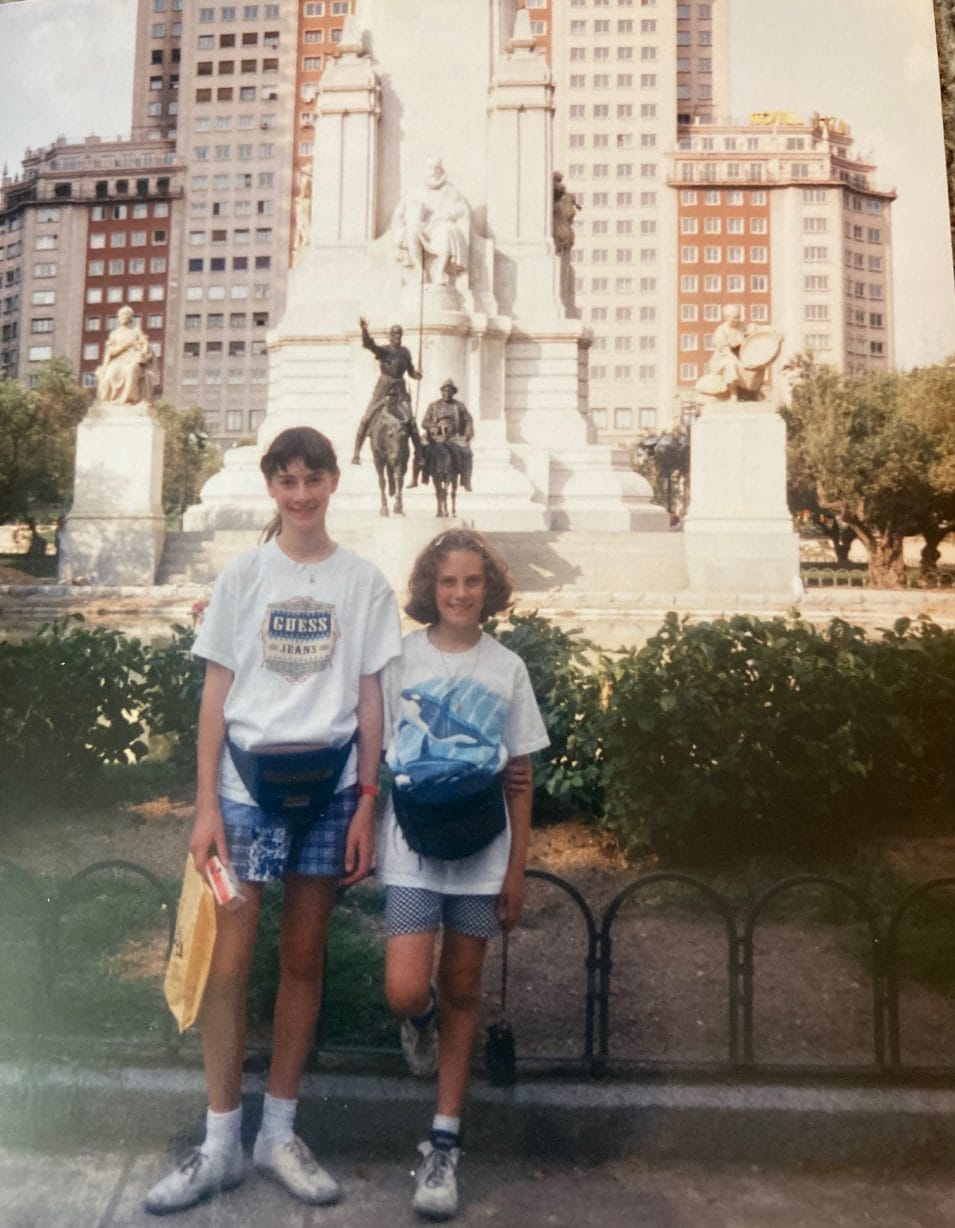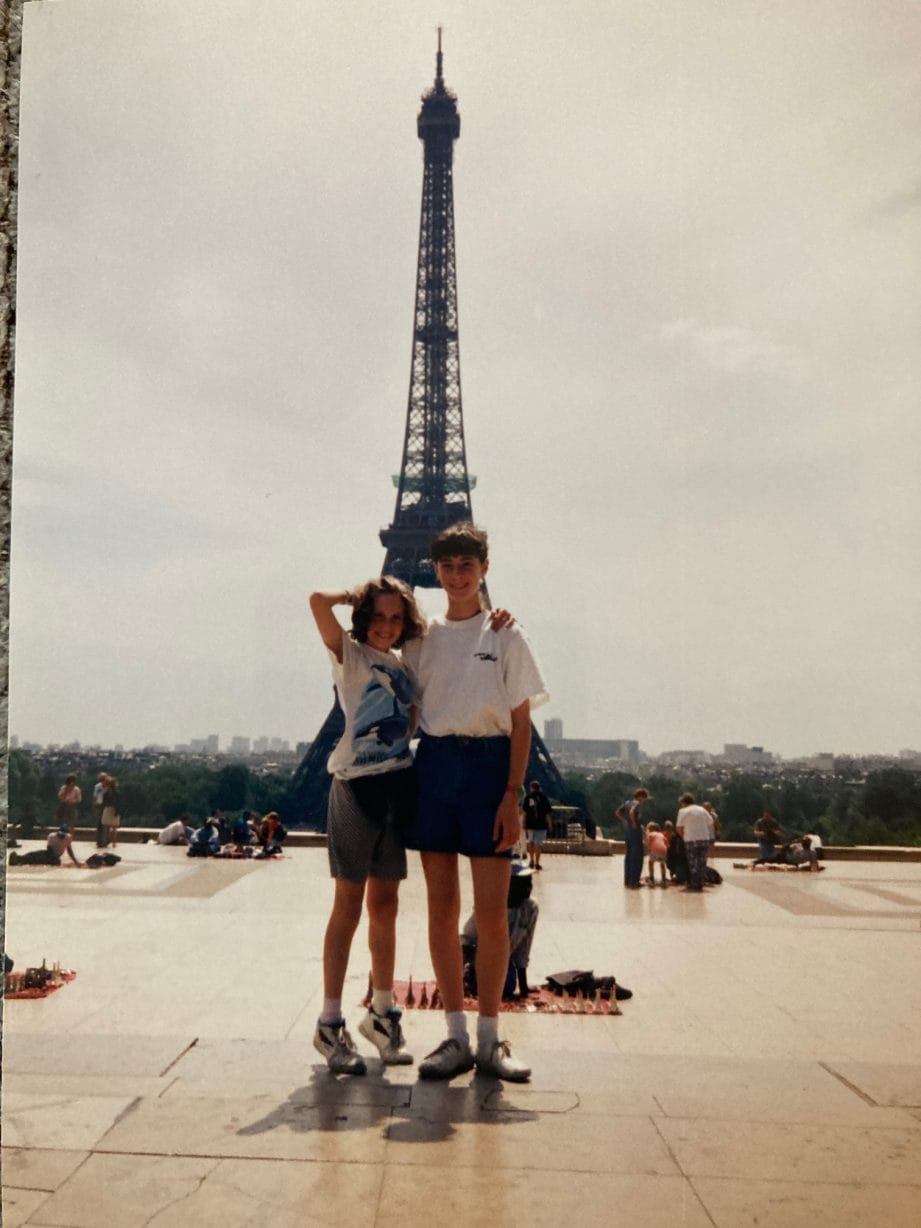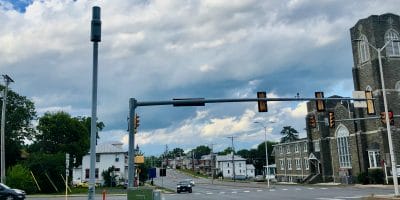A contributed perspectives piece by Anna Rose Geary

The author’s daughters, Teresa 13 and Maria 10, in 1995 on the trip from Madrid to Paris
Of all the international trips I have led in the last 30 years, the one that stands out the most is that of 1992.
That year, I couldn’t wait for school to end and to begin the trip to Spain and France, although traveling with 22 middle-schoolers and five adult chaperones seemed a little scary. I hoped the students would remember the pep talks I had given them throughout the year about behavior in public places and the importance of staying in their rooms at night. Walking the hotel halls and sleeping in each other’s rooms was absolutely not to be tolerated! In fact, I surprised them by saying that I was going to tape their doors shut after curfew time with masking tape, and would know who left their rooms, because I would see the broken tape while on hall inspection through the night. The kids were very sober about this. What I didn’t think about was that traveling on a night train for nine hours was going to be a whole different experience.
The highlights of the tour in Madrid were a flamenco show, the Prado Museum and tapas at great restaurants. The flamenco was on the last night in Madrid, our farewell to Spain, before we left by train for France. The show we attended was held in the grand ballroom of a city-central hotel, an imposing venue, that was basically for tourists. Several hundred people were in attendance, sitting at small tables, eating tapas. Clouds of smoke from cigars and cigarettes made it almost impossible to see the dancers on stage, but the kids loved stomping their feet under the tables in rhythm with the castanets and shouting Ole’ every time the dancers twirled their brightly colored stage gowns around.
Eating and entertainment begins late in Spain, past 9:00 PM. By the time we got the group out of the flamenco show and onto the bus to head to the train station, we were running late. The bus was able to leave immediately because the baggage had been pre-boarded, but traffic was bad. I could read the tour director’s face, which conveyed extreme worry. Soon he was using the onboard bus telephone (no cell phones at the time), to call the train station. With nearly thirty people not getting to the train on time, he was loudly pleading, then shouting, with the train master to hold up the train for ten minutes. This is never done in Europe, but because of the number of our group, the agreement was reached and the bus driver hit the gas and got to the destination shortly, speeding all the way.
The all-night train was scheduled to leave Atocha Station at 11 p.m. We arrived at the station at 11:10 p.m. and ran a mad, half mile dash from the bus to the train platform, dragging all the luggage, with some pieces losing wheels along the way, and throwing the bags into open windows and doors as the train started to pull out slowly, while we were still in the process of boarding. I feared that we would leave some students behind. Thankfully, they all hopped on board! And I was the last on, a river of sweat pouring out and a heart racing with panic. Ah, now I could finally relax, I thought. Not!
The group was very revved up by the time we hit the sleeping cars, the “couchettes,” dragging along their half-broken suitcases and bags of souvenirs, trying to find seats and rooms. The already seated passengers wore looks of great disdain as the students were attempting to get settled. I and the chaperones were constantly “shushing” the students. No one paid any attention.
The most unexpected accommodations were the “couchettes.” As a student group, we were assigned the cheapest sleeping quarters, which meant that six students were to sleep in three-tier bunk beds on two sides of a very small compartment! The adults had two bunk beds in a room, sleeping four. I wondered if this was a recipe for a disaster. How were six boys in a room going to sleep through the night? The plan I devised was that I and my husband would squeeze into a top bunk and five boys would sleep in the other bunks in the room. The remaining boys would sleep in a room with two other male chaperones. The two female adults were assigned rooms with the girls. Somehow, the plan seemed to work because everyone had a bed and every compartment was supervised.
During the summer months, days in Europe are very long and nights are short, especially around the time of the solstice. By midnight, although there was no sun, the sky was still pale shades of blue and grey. No electric lights had come on yet in the train. I thought nothing of this. The students had made their way to and from the snack car without any problem and were chattering, eating and drinking. For a bit, the noise level had dropped and I noticed that some students had huddled together to talk and others were nodding off. A few told me they were going to the end of the car to use the restrooms and I gave them permission. Another group then asked me if they could go to the opposite end and use the restrooms there. That didn’t seem to be a problem since none of them needed to leave the train car. More permission.

The author’s daughters, Teresa 13 and Maria 10, in 1995 on the trip from Madrid to Paris
After around 15 minutes, I wondered where the students were. Half of the group was gone. As I was getting ready to organize a search party of chaperones, I and others heard a big commotion at both ends of the train car. Staring in disbelief, we saw mummy figures banging spoons together and heard voices singing the theme from the TV series, “The Addams Family.” A parade of neck to toe, toilet paper wrapped kids, were snapping their fingers, dancing and twirling down the train aisle. They continued singing, switching from the first song to “When the Saints Go Marching In!” The passengers were flabbergasted! The kids in the seats jumped up and joined their friends in the parade. Two conductors, hearing the commotion, ran into the car, and shouted in Spanish and broken English, SIT DOWN! I was mortified! The chaperones and I then got the students settled and began the process of unwrapping piles of toilet paper from the mummies. By this time, it was 12:30 a.m. We noticed there were no lights on in the train. Little did we know that the worst was yet to come.
The summer of 1992 was a big one for Spain. The Expo’92, celebrating the 500thanniversary of the year of Columbus’ Discovery of the New World in 1492, began in Seville in April and went on into the fall. The Summer Olympics were held in Barcelona. There was a lot of national pride displayed on Spanish streets, with flags of both events flying from a great many buildings. Stores were stocked with t-shirts, postcards and all sorts of memorabilia. Although Spain had been preparing for a couple of years for hundreds of thousands of tourists to descend on the country, the infrastructure was not ready and still left a lot to be desired.
When my group boarded the train in Madrid, I noticed that it appeared rather old and dusty. The upholstery was torn and the overhead fans did not work. The lights were not on, but I figured that was because there was still daylight outside. What I found out from the conductor was that the lights were never going to come on until the train engine was changed at the French border. The only light on the train was the big searchlight at the front. No small searchlights for passengers were available. Two of the fathers were insurance agents and that was the worst news they could hear. Anything could happen on the train! They were threatening to sue the train company if the lack of lights caused personal injuries.
Trains run over 150 miles per hour in Europe. This train was old and although it didn’t travel that fast, it rattled and swayed immensely. The students were scared. They needed to use the restroom but couldn’t see where they were going. The fathers said that strange men could come into the train car and try to rape the girls! What about murder, like on the “Orient Express!” Some girls overheard this news, told others, and the crying and wailing started. I had no idea what to do except to confine everyone to their bunks. All the adults then wound up sitting in seats during the rest of the night, keeping watch over the students and the train. The conductor told us the train had been checked for safety but no one knew why the lights weren’t on. We were reassured that once the engine was changed at the border and the train was put on French tracks, which were better than Spanish ones, all would be well. I found out the train was a 1952 model. I was really worried!
At 4:15 a.m. we slowed down, reached the Pyrenees Mountains, the French border. There was a lot of shouting on the platform and an engine pulled up. We felt the train car rise slightly, pushed onto new tracks, and the multiple whistle blasts indicated the new engine was attached. All the lights finally went on and whatever students were sleeping, woke up. We reassured the group that everything would be fine and sent them back to bed. My husband Bob and I climbed onto the top bunk in the boys’ compartment, stepping on somebody’s face, but nobody cared. Safe at last!
Three hours later the train slowed down and prepared for arrival at the Gare du Nord in Paris. A unenviable task lay ahead of me – waking up tired, sleep- deprived kids, getting the luggage together, and moving everyone and their belongings off the train, to begin the next adventure in the land of the Eiffel Tower.
Anna Rose Geary is a retired teacher of social studies and a reading specialist for Staunton City Schools. She has lived in Harrisonburg since 1971, but is originally from Brooklyn, NY.











